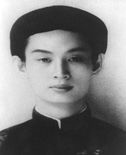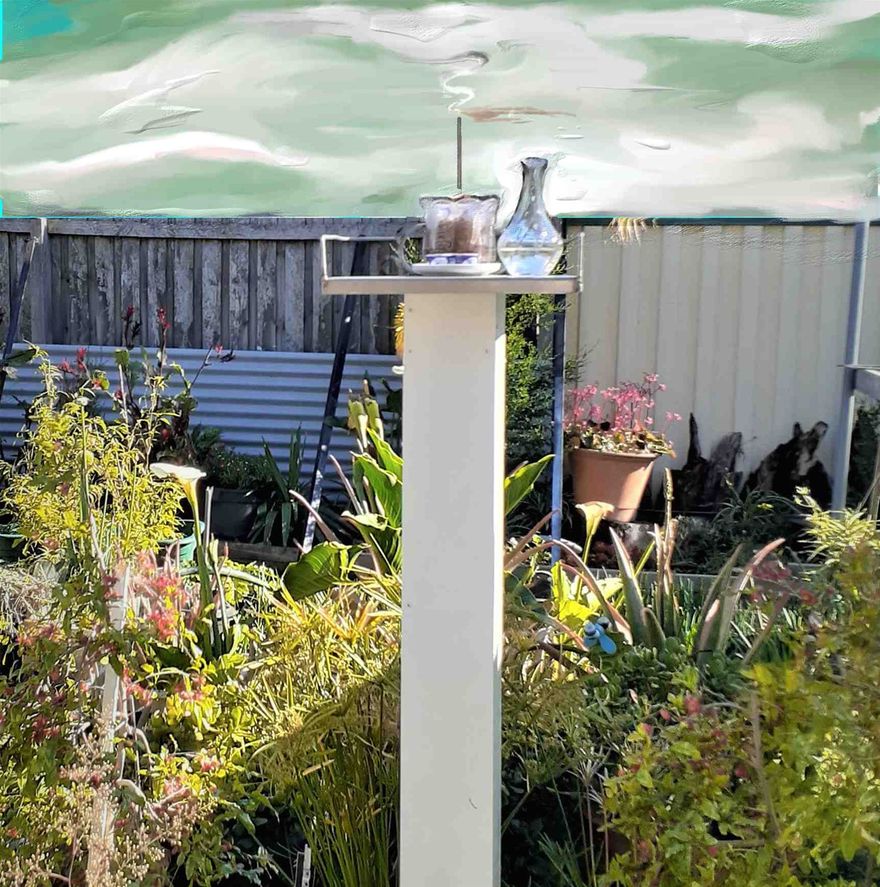PHẬT GIÁO HÒA HẢO
HARMONY BUDDHISM
SỰ CÚNG LẠY CỦA NGƯỜI CƯ-SĨ TẠI-GIA
BÀI NGUYỆN TRƯỚC BÀN THỜ ÔNG BÀ
Cầm hương xá 3 xá, quì xuống chắp tay đưa lên trán nguyện:
Cúi kính dưng hương trước Cửu-Huyền,
Cầu trên Thất-Tổ chứng lòng thiềng.
Nay con tỉnh-ngộ quy-y Phật,
Chỉ dốc tu hiền tạo phước-duyên.
Cắm hương rồi đứng ngay thẳng chắp tay vào ngực đọc tiếp:
Cúi đầu lạy tạ Tổ-Tông,
Báo ơn sanh-dưỡng dày công nhọc-nhằn.
Rày con xin giữ Đạo hằng,
Tu cầu Tông-Tổ siêu thăng Phật-đài.
Nguyện làm cho đẹp mặt mày,
Thoát nơi khổ hải Liên-đài được lên.
Mong nhờ Đức Cả bề trên,
Độ con yên-ổn vững bền cội tu.
(lạy 4 lạy)
BÀI NGUYỆN TRƯỚC BÀN THỜ PHẬT
Cầm hương xá 3 xá, quì xuống chắp tay đưa lên trán đọc bài Quy-Y:
Nam-mô Ta-Bà Giáo-Chủ Bổn-Sư Thích-Ca Mâu-Ni Phật (tam niệm).
Nam-Mô Thập Phương Phật.
Nam-Mô Thập Phương Pháp.
Nam-Mô Thập Phương Tăng.
Nam-Mô Phật-Tổ, Phật-Thầy, Quan Thượng-Đẳng Đại thần, chư quan cựu thần, chư vị sơn-thần, chư vị Năm Non Bảy Núi, cảm-ứng chứng-minh, nay con nguyện cải-hối ăn-năn, làm lành lánh dữ, quy-y theo mấy Ngài, tu hiền theo Phật Đạo.
Cắm hương lạy 4 lạy cũng được hoặc cắm hương đứng ngay thẳng chắp tay vào ngực đọc tiếp:
Nam-mô Tây-Phương Cực-Lạc thế giới Đại-từ Đại-bi phổ độ chúng-sanh A-Di-Đà Phật.
Nam-mô nhứt nguyện cầu: Thiên-Hoàng, Địa-Hoàng, Nhơn- Hoàng, Liên-Hoa hải-hội, thượng Phật từ-bi, Phật-vương độ chúng, thế-giới bình- an.
Nam-mô nhị nguyện cầu: Cửu-huyền Thất-tổ Tịnh-độ siêu sanh.
Nam-mô tam nguyện cầu: Phụ-mẫu tại đường tăng long phước thọ, phụ-mẫu quá khứ trực vãng Tây-phương.
Nam-mô tứ nguyện cầu: Bá-tánh vạn dân từ-tâm bác-ái, giảithoát mê-ly.
Nam-mô ngũ nguyện cầu: Phật-tổ, Phật Thầy từ-bi xá tội đệ-tử tiêu tai tịnh sự, trí-huệ thông-minh, giai đắc đạo quả.
Lạy 4 lạy rồi xá: 1 xá chính giữa niệm: Nam-Mô A-Di-Đà Phật. 1 xá bên trái niệm: Nam-Mô Đại-thế-Chí Bồ-tát. 1 xá bên mặt niệm: Nam-Mô Quan-thế-Âm Bồ-tát.
BÀN THÔNG THIÊN
Cầu nguyện bàn Phật xong, ra bàn Thông Thiên cầu nguyện 4 hướng (lấy bàn Thông Thiên làm hướng chánh) trước mặt, sau lưng, hai bên vai.
Hướng chánh bàn Thông Thiên có nguyện đọc bài Quy-Y, còn ba hướng kia chỉ đọc bài Tây-phương ngũ nguyện, (mỗi hướng đọc rồi lạy 4 lạy).
(Khi cầu nguyện nếu không thể lạy được thì xá 3 xá). Lạy đứng hay lạy quì tùy theo lúc yếu mạnh.
NIỆM PHẬT
Cúng xong muốn niệm Phật cũng được. Ngồi bán già thẳng lưng niệm: Nam-Mô A-Di-Đà Phật. Hay Niệm: Nam-mô Tây-phương Cực-lạc thế giới tam thập lục vạn ức, nhứt thập nhứt vạn, cửu thiên ngũ bá đồng danh đồng hiệu đại-từ đại-bi phổ-độ chúng-sanh A-Di-Đà Phật.(1)
(Niệm Phật nhiều ít tùy theo sức mình, lúc cầu-nguyện và niệm Phật chỉ niệm trong tâm).
Nam-Mô A-Di-Đà Phật, sáu chữ đi, đứng, nằm, ngồi, rán niệm chớ quên, không đợi gì thời-khắc.
KHI ĂN CƠM
Mỗi khi ăn cơm với mắm muối chi cũng vậy đều nguyện vái Cửu-huyền, Thất-Tổ, ông bà cha mẹ quá vãng về ăn với mình để tỏ lòng hiếu-thảo.
ĂN CHAY
Đến ngày đơm-quảy có chi cúng nấy. Ăn chay ngày 14-15, 29-30, tháng thiếu 29 và mồng 1, có nhang thì đốt, không có thì nguyện không.
Hằng năm đến ba ngày xuân nhựt thì ngày 29-30 và mồng 1 phải ăn chay, trong mấy ngày ăn chay phải cúng chay, qua đến ngày mồng 2 có chi cúng nấy cũng được, đến ngày mồng 3 ra mắt không nên sát-sanh loài vật mà cúng tế Trời Phật, chỉ dùng bông hoa mà cúng thôi .
ĐI XA NHÀ
Đi làm ruộng đến thời cúng, ngó về hướng Tây nguyện rồi xá 4 hướng. Còn đi xa nhà thì nguyện tưởng trong tâm cũng được.
(1) 36,000,000,119,500.00 (the calculation may be subject to review) based on the Hán Nôm writing. 三十万亿一十一万九天五百
WORSHIPPING RITES OF LAY PRACTICER
PRAYER BEFORE THE ANCESTRAL ALTAR
Clasping the incense stick, salute three times, kneeling with hands clasped against your forehead, pray:
I respectfully offer incense to my Ancestors,
Would you please bear witness to my candor?
Now I wake up to take refuge in Buddha,
I resolved to be a merit-cultivator.
Plant the incense, stand straight, clasp your hands against your chest praying on:
I kowtow to acknowledge my ancestors,
For your birth-giving and raising labor.
From now on, I am devoted to Buddhism,
For You to ascend to the Holy realm.
I vow to be your name shiner,
Free from sufferings for the Lotus seater.
I beg for your Grace from above,
Help me steadily practice the Tao.
(Four Prostrations)
PRAYER BEFORE THE THREE JEWEL ALTAR
Clasping the incense stick, salute three times, kneel and hands held against the forehead praying:
Namo The Saba World Lord Master Sakyamuni Buddha (Three Times)
Namo the Ten Directions Buddha
Namo the Ten Directions Dharma
Namo The Directions Sangha
Namo the Patriarch Buddha, the Master Buddha, Lord Generalissimo, Ancient Mandarins, Mountain Gods, the Sacred Residents of Nam Non, Bay Nui, May You Witness My Vow: I shall repent and renounce bad and do good, take refuge in the Lords and practice Buddhism.
After planting the incense, kowtow four times or stand straight with hands clasped against the chest and pray on:
Namo the Western Paradise, the World of Great Compassion and Magnanimity, may you kindly and lovingly bless all the sentient beings, Amitabha.
Namo the First Prayer: Heavenly King, Earthly King, Human King, Great Lotus Assembly, Master Buddhas, and Buddha King, May you compassionately bestow peace over the world.
Namo the Second Prayer: May all our Ancestors ascend to the Pure Land.
Namo the Third Prayer: May our alive parents enjoy greater merits and longevity; the late ones ascend to the Western Paradise.
Namo the Fourth Prayer: May all the masses be tolerant, generous, and no longer delusional.
Namo the Fifth Prayer: May our Patriarch Buddha and Master Buddha mercifully bless Us, free from karmic impediments, insightful, and fully enlightened.
Kowtow four times, stand up and one salute in the middle: Namo Amitabha, one salute on the left: Namo Mahàsthàma Bodhisattva, and one salute on the right: Namo Avalokitesvara Bodhisattva.
OPEN-AIR ALTAR
After finishing the prayer before the Three Jewel Altar, pray before the Open-Air Altar in the Four Directions (the Open-Air Altar is in the main direction) front, back, left, and right.
Read the Prayer for Taking Refuge and Five Prayers toward the Western Paradise in the main direction, and read the latter in the remaining three ones. (Each has Four Prostrations). If you can’t prostrate standing, you may salute three times. Standing and kneeling depend on your actual health condition.
RECITING AMITABHA
After the ritual, it is possible to recite Amitabha.
Half leg-crossing, the back straight up, pray: Namo Amitabha Or recite: “Namo The Western Paradise, the Thirty-Six Trillions, One Hundred and Nineteen Thousand and Five Hundred Worlds, the same sound and same name, with great compassion, bless the living, Amitabha.”
(The reciting of Amitabha only happens in mind, and the number of recitations varies in accordance with your health)
MEALTIME
Each time you take your meals with whatever, pray for the Ancestors, the late grandparents and/or parents to return and share it with you to show your filial piety.
FASTING
On the commemorative days, you may offer whatever you have. Be vegan on the 14th, 15th, 29th, or 30th of the month, and in the shorter one, you may eat on the 29th and the 1st. If you have incense, you burn it; otherwise, you pray without.
Every year, on the New-Year’s Eve, you fast on the 29th, the 30th, and the 1st day, during which you must offer non-animal food. On the 2nd day, you can offer whatever you have, and on the 3rd, do not kill animals to sacrifice for the Supreme, but flowers only.
AWAY FROM HOME
When you go to work on the farm and, at praying times, look toward the West and kowtow in four directions. If you are far away from home, you may pray in mind.
Bàn Thông Thiên ---- Open-Air Altar


